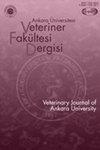EXPRESSION AND DISTRIBUTION OF GPR55 AND GPR119 DURING THE DEVELOPMENT OF RAT TESTIS
IF 0.9
4区 农林科学
Q3 VETERINARY SCIENCES
引用次数: 0
Abstract
G Protein-Coupled Receptors, GPR55 and GPR119 are widely distributed throughout the body and exert important biological functions. However, little is known about their roles in testis. This study aimed to examine the expression and distribution of GPR55 and GPR119 during the development of the rat testis. Sixty male Sprague Dawley rats (180–240 g) were divided into 10 groups as 7, 14, 21, 28, 35, 42, 49, 56, 63, and 70 postnatal days of age (PND) (six animals per group). The testicular expression of GPR55 and GPR119 has been investigated by immunohistochemistry, Western blot, and quantitative RT-PCR methods. We observed that GPR55 and GPR119 are expressed throughout the rat testis development from PND 7 to 70. However, no difference was observed between the groups in terms of expression levels, except for GPR55 mRNA expression in the group of PND 7. Immunohistochemistry analysis showed that GPR55 is expressed in spermatids and spermatocytes in the mid-term tubules and spermatocytes in the late-stage tubules in groups of PND 56, 63, and 70. For GPR119, very intense positivity was observed only in spermatids in the mid-term (stage VII-VIII) tubules in the groups of PND 56, 63, and 70. No significant difference was observed in the number of GPR55 and GPR119 positive cells in testes from PND 56 through PND 70. Taken together, both GPR55 and GPR119 receptors are expressed throughout the rat testis development (PND 7 to 70). These results suggest that GPR55 and GPR119 are involved in the modulation of male reproductive function.gpr55和gpr119在大鼠睾丸发育过程中的表达和分布
G蛋白偶联受体GPR55和GPR119广泛分布于全身,具有重要的生物学功能。然而,人们对它们在睾丸中的作用知之甚少。本研究旨在检测GPR55和GPR119在大鼠睾丸发育过程中的表达和分布。选用180 ~ 240 g雄性sd大鼠60只,按出生后7、14、21、28、35、42、49、56、63、70日龄(PND)分为10组,每组6只。采用免疫组织化学、Western blot和定量RT-PCR方法研究了GPR55和GPR119在睾丸中的表达。我们观察到GPR55和GPR119在PND 7至70的整个大鼠睾丸发育过程中表达。然而,除了PND 7组的GPR55 mRNA表达外,各组之间的表达水平无差异。免疫组化分析显示,在PND 56、63和70组中,GPR55在中期小管精母细胞和晚期小管精母细胞中表达。在PND 56、63和70组中,GPR119仅在中期(VII-VIII期)小管的精细胞中观察到非常强烈的阳性。从PND 56到PND 70,睾丸中GPR55和GPR119阳性细胞的数量无显著差异。综上所述,GPR55和GPR119受体在大鼠睾丸发育过程中均有表达(PND 7 ~ 70)。这些结果表明GPR55和GPR119参与了男性生殖功能的调节。
本文章由计算机程序翻译,如有差异,请以英文原文为准。
求助全文
约1分钟内获得全文
求助全文
来源期刊
CiteScore
1.50
自引率
0.00%
发文量
44
审稿时长
6-12 weeks
期刊介绍:
Ankara Üniversitesi Veteriner Fakültesi Dergisi is one of the journals’ of Ankara University, which is the first well-established university in the Republic of Turkey. Research articles, short communications, case reports, letter to editor and invited review articles are published on all aspects of veterinary medicine and animal science. The journal is published on a quarterly since 1954 and indexing in Science Citation Index-Expanded (SCI-Exp) since April 2007.

 求助内容:
求助内容: 应助结果提醒方式:
应助结果提醒方式:


